
Energy
“Energy”
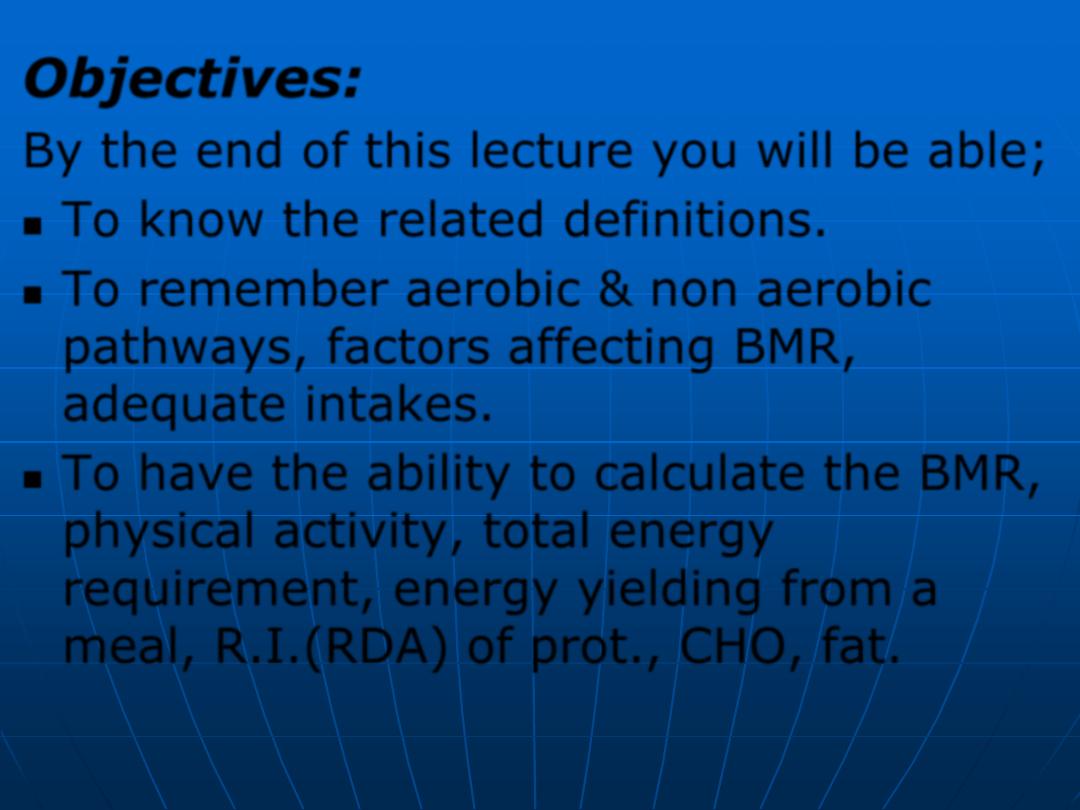
Objectives:
By the end of this lecture you will be able;
To know the related definitions.
To remember aerobic & non aerobic
pathways, factors affecting BMR,
adequate intakes.
To have the ability to calculate the BMR,
physical activity, total energy
requirement, energy yielding from a
meal, R.I.(RDA) of prot., CHO, fat.
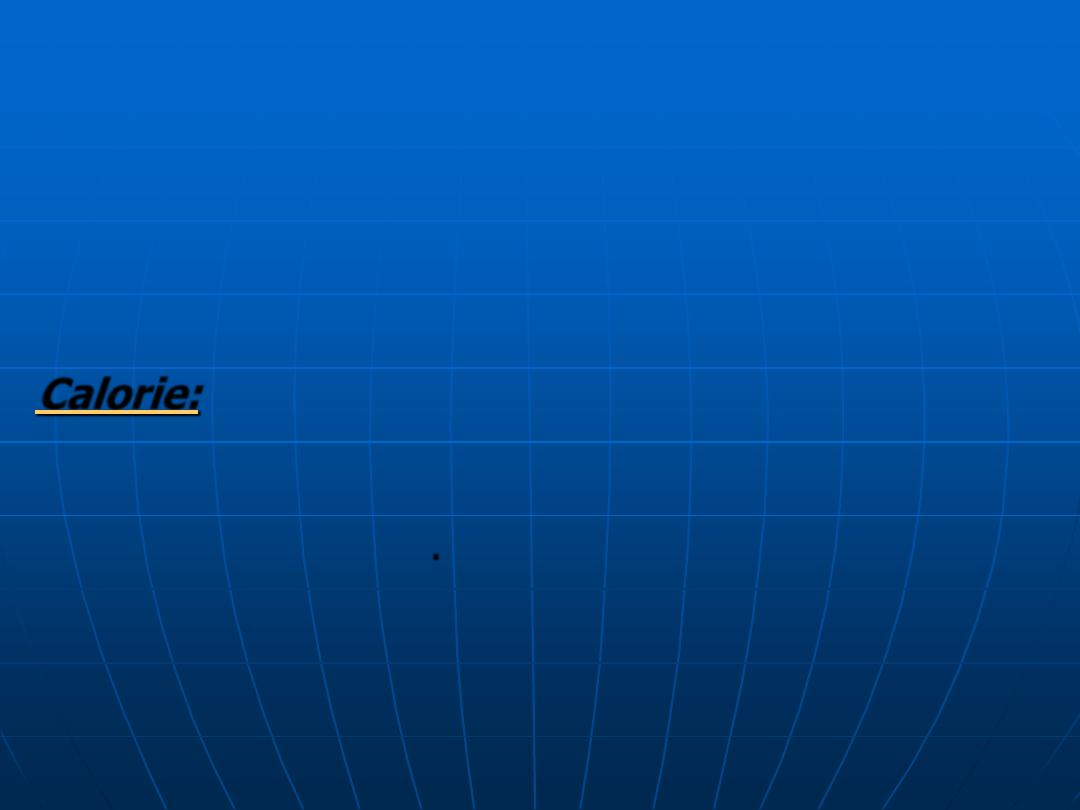
Energy:
Is the ability to perform work, produce
change,& maintain life.
In the body, chemical energy from food is converted to
mechanical energy & heat.
The major dietary sources of energy-yielding are
CHO
,
fats & proteins.
Calorie:
it is the basic unit of energy.
It is the amount of heat energy required to raise the
temperature of one gram of water by 1°C at the
standard temperature.
But because the calorie is a small unit we usually use;
Kilocalorie (Kcal or Cal) =1000 calories:
Which is the amount of heat energy required to raise
the temp. of a kilogram of water 1°C.
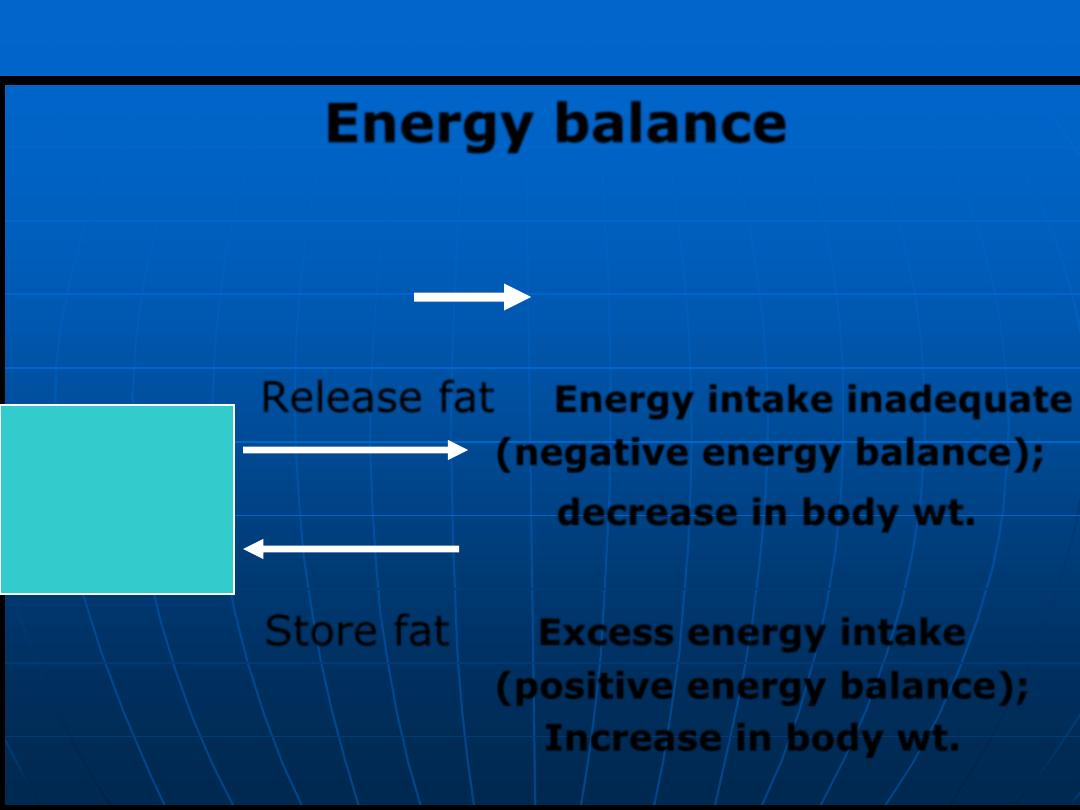
Energy balance
Energy IN = Energy OUT
Energy intake 24h Energy expenditure
Release fat
Energy intake inadequate
(negative energy balance);
decrease in body wt.
Store fat
Excess energy intake
(positive energy balance);
Increase in body wt.
Adipose
tissues
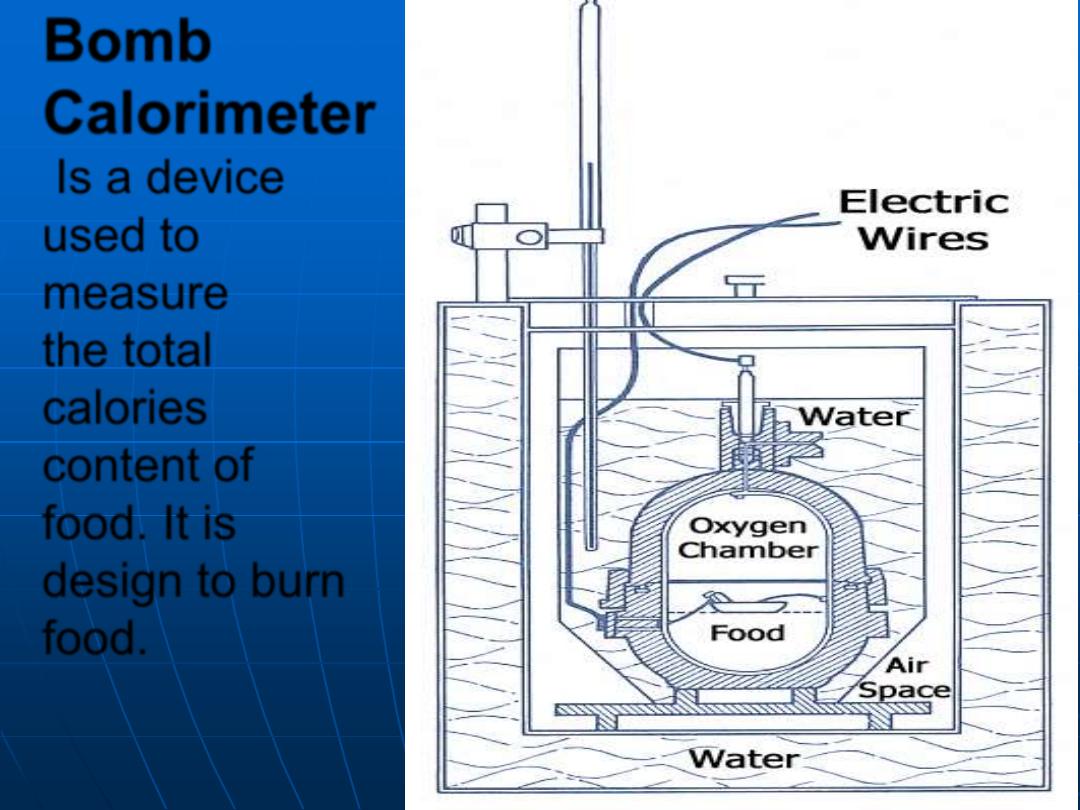
Bomb
Calorimeter
Is a device
used to
measure
the total
calories
content of
food. It is
design to burn
food.
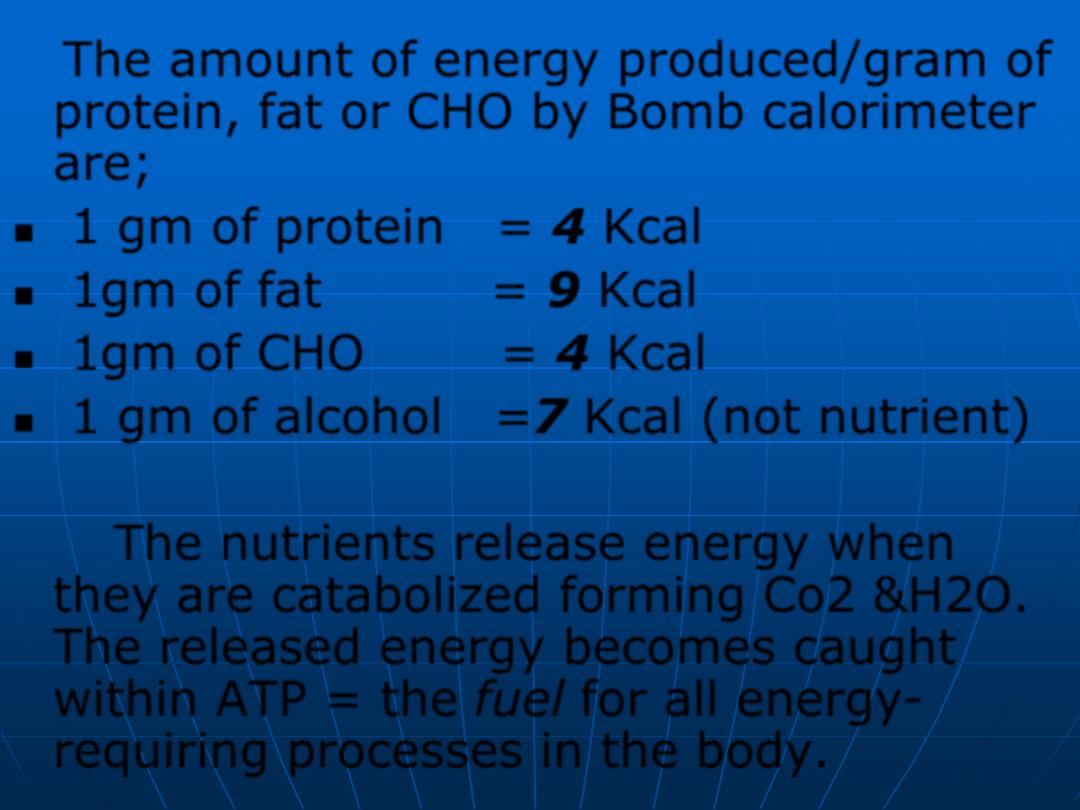
The amount of energy produced/gram of
protein, fat or CHO by Bomb calorimeter
are;
1 gm of
protein = 4 Kcal
1gm of
fat
= 9 Kcal
1gm of
CHO = 4 Kcal
1 gm of alcohol =7 Kcal (not nutrient)
The nutrients release energy when
they are catabolized forming Co2 &H2O.
The released energy becomes caught
within ATP = the fuel for all energy-
requiring processes in the body.
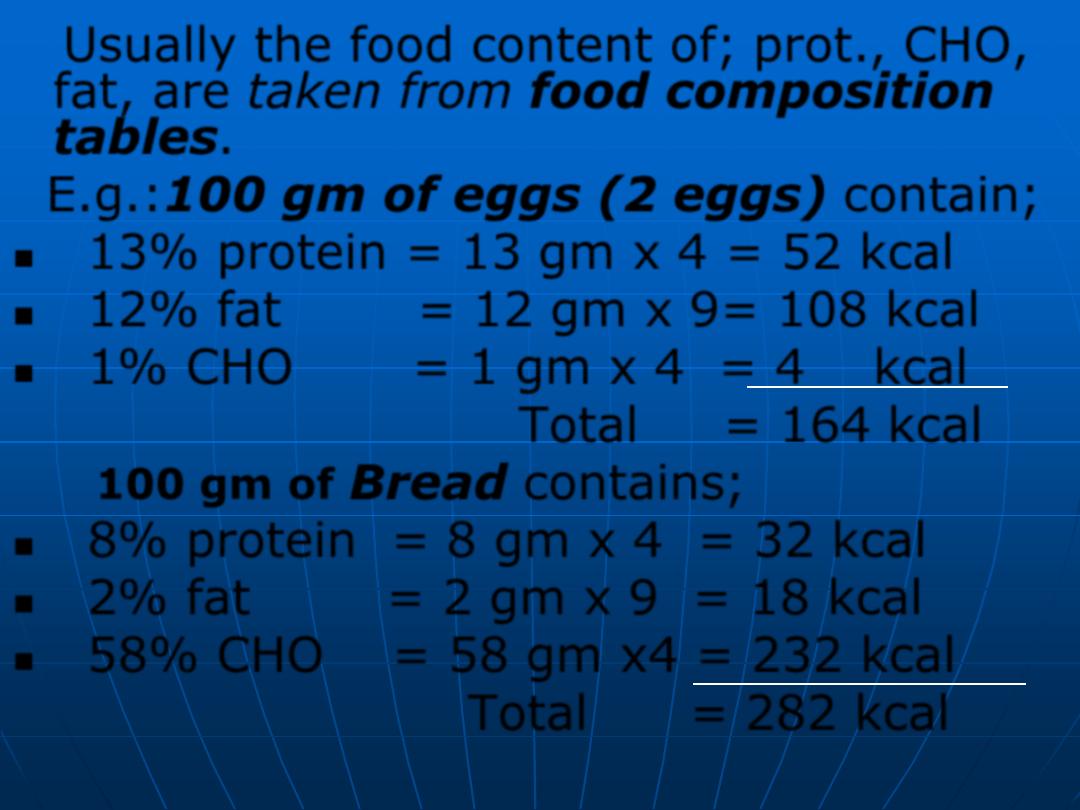
Usually the food content of; prot., CHO,
fat, are taken from food composition
tables.
E.g.:
100 gm of eggs (2 eggs) contain
;
13% protein = 13 gm x 4 = 52 kcal
12% fat = 12 gm x 9= 108 kcal
1% CHO = 1 gm x 4 = 4 kcal
Total = 164 kcal
100 gm of
Bread contains
;
8% protein = 8 gm x 4 = 32 kcal
2% fat = 2 gm x 9 = 18 kcal
58% CHO = 58 gm x4 = 232 kcal
Total = 282 kcal

100 cc of milk = ½ cup
contain;
3.5% protein = 3.5 gm x 4 = 14 kcal
3.5% fat = 3.5 gm x 9 = 31.5 kcal
5% CHO = 5 gm x 4 = 20 kcal
Total = 65.5 kcal
Cup of milk = 200 cc = 200 gm
One table spoonful = 15 cc = 15 gm
One tea spoonful = 5 cc = 5 gm
One tea spoonful of oil= 5 gmx9= 45kcal
One tea spoonful of sugar=5gmx4=20kcal
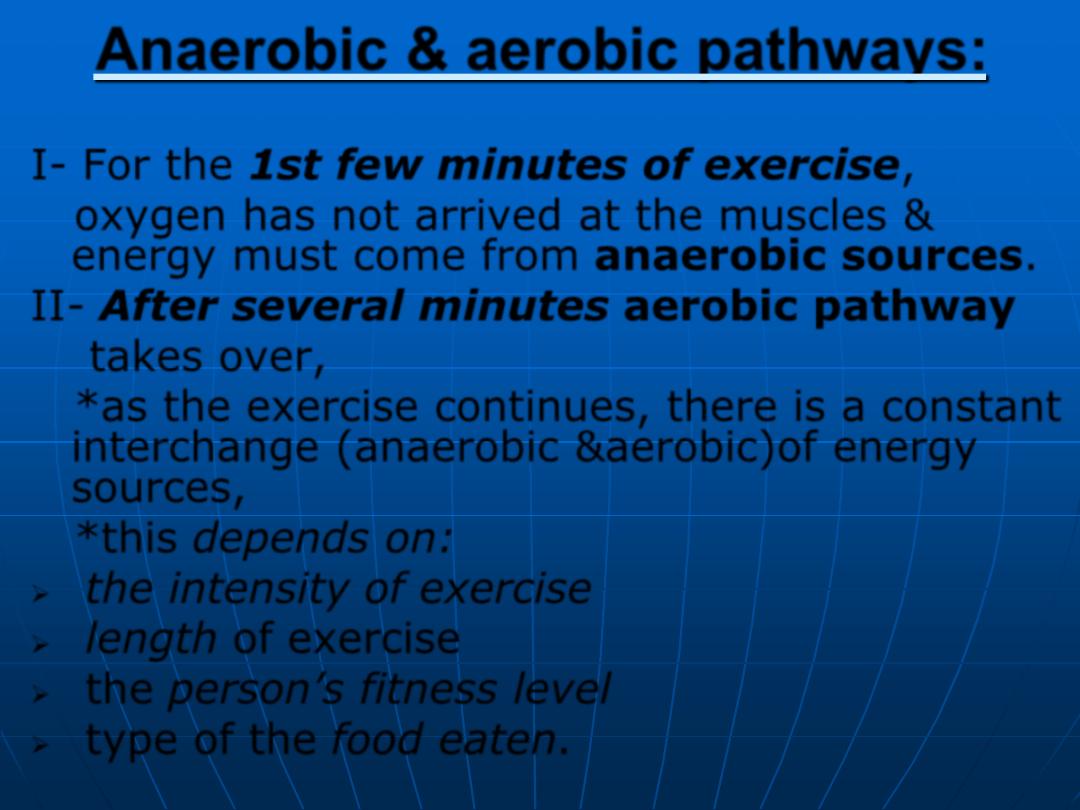
Anaerobic & aerobic pathways:
I- For the
1st few minutes of exercise
,
oxygen has not arrived at the muscles &
energy must come from
anaerobic sources.
II-
After several minutes
aerobic pathway
takes over,
*as the exercise continues, there is a constant
interchange (anaerobic &aerobic)of energy
sources,
*this
depends on:
the intensity
of exercise
length of
exercise
the
person’s fitness level
type of the
food eaten
.
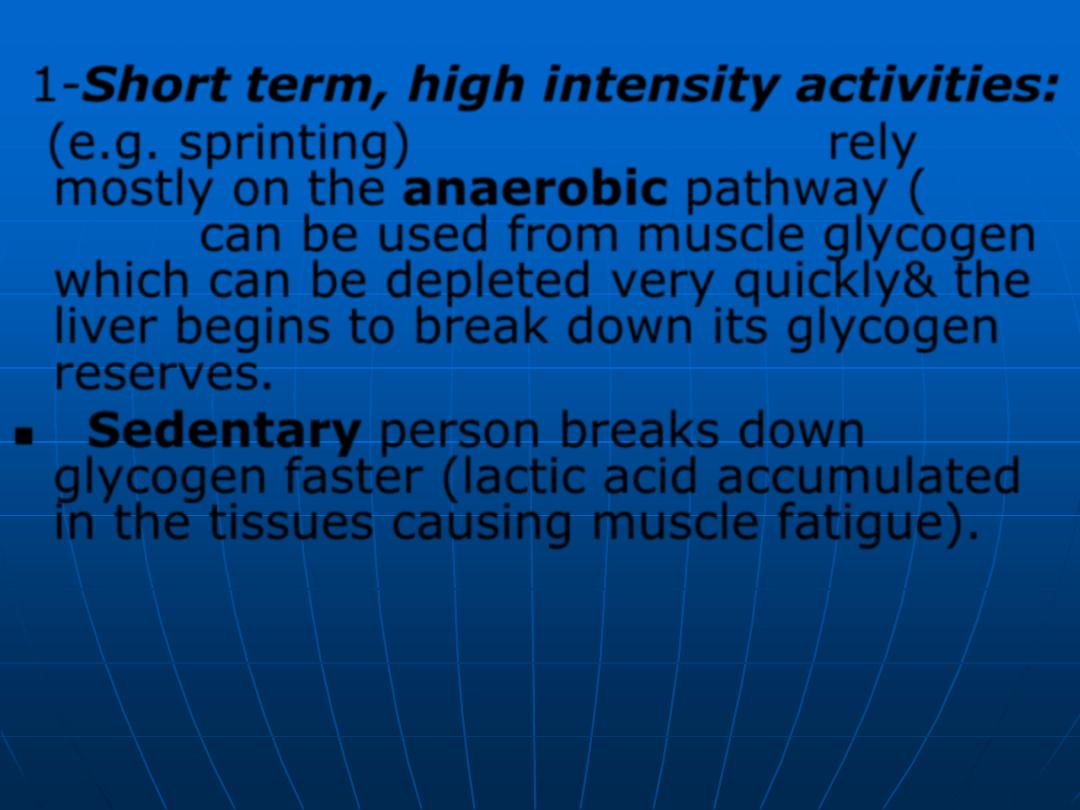
1-
Short term, high intensity activities:
(e.g. sprinting) first 20 minutes rely
mostly on the
anaerobic
pathway
(only
CHO)
can be used from muscle glycogen
which can be depleted very quickly& the
liver begins to break down its glycogen
reserves.
Sedentary
person breaks down
glycogen
faster (lactic acid accumulated
in the tissues causing muscle fatigue).
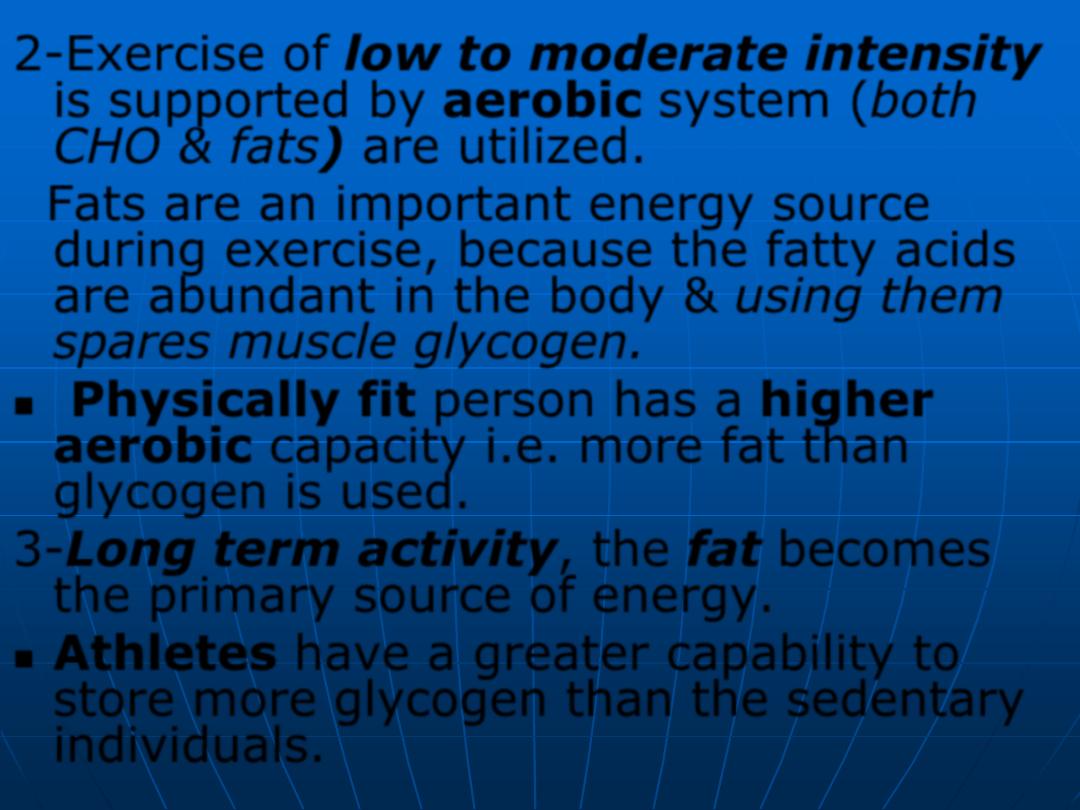
2-Exercise of
low to moderate intensity
is supported by
aerobic
system (
both
CHO & fats)
are utilized.
Fats are an important energy source
during exercise, because the fatty acids
are abundant in the body & using them
spares muscle glycogen.
Physically fit
person has a
higher
aerobic
capacity i.e.
more fat than
glycogen
is used.
3-
Long term activity
, the
fat
becomes
the primary source of energy.
Athletes have a greater capability to
store more glycogen than the sedentary
individuals.
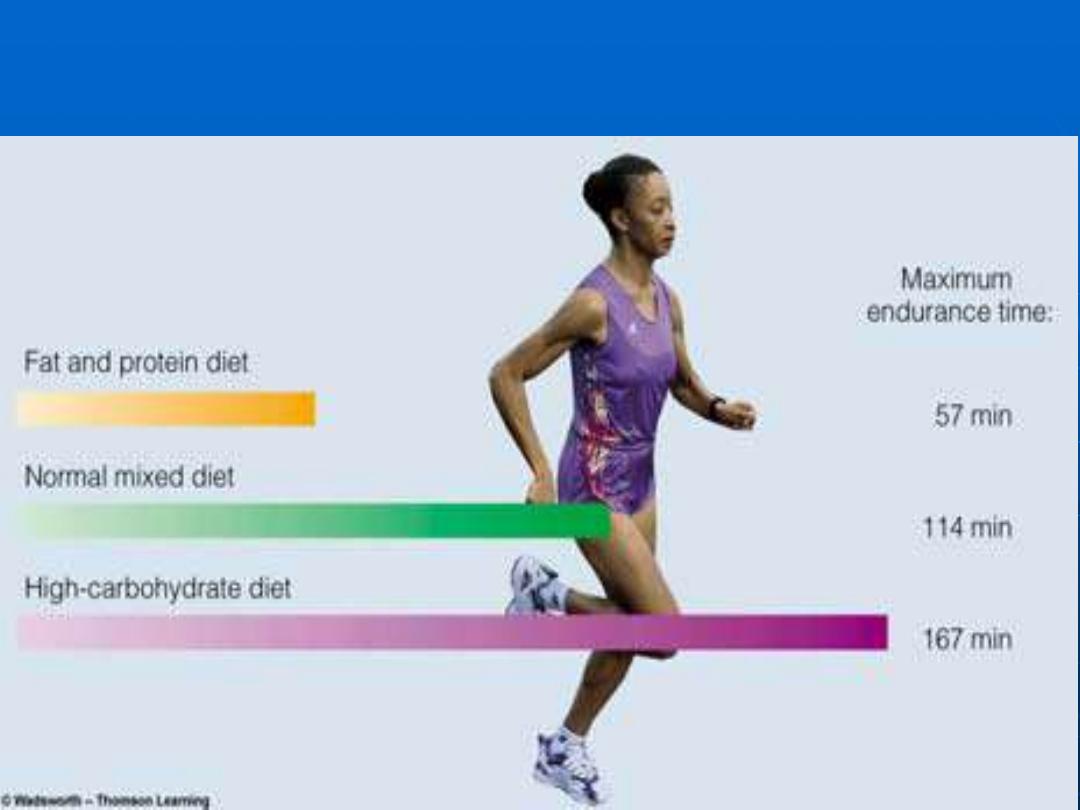
Glucose Use
Diet affects glycogen storage &use
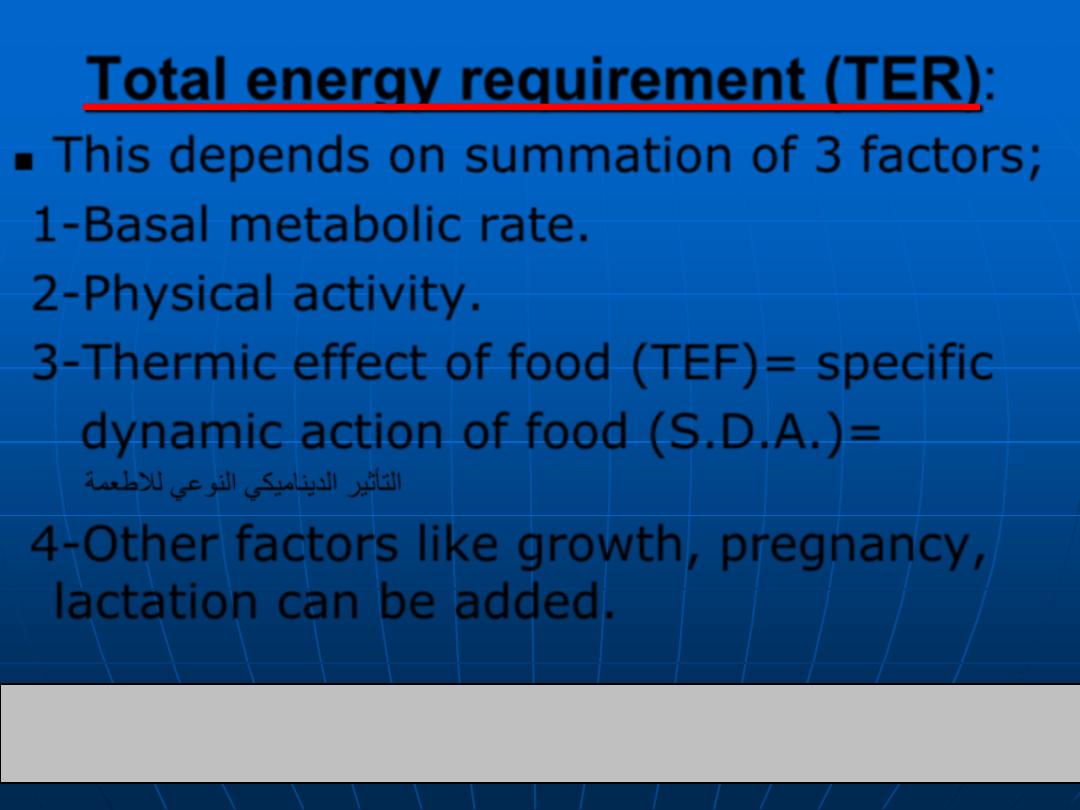
Total energy requirement (TER):
This depends on summation of 3 factors;
1-Basal metabolic rate.
2-Physical activity.
3-Thermic effect of food (TEF)= specific
dynamic action of food (S.D.A.)=
التأثير الديناميكي النوعي لالطعمة
4-Other factors like growth, pregnancy,
lactation can be added.
Energy requirement =BMR+ physical activity +TEF
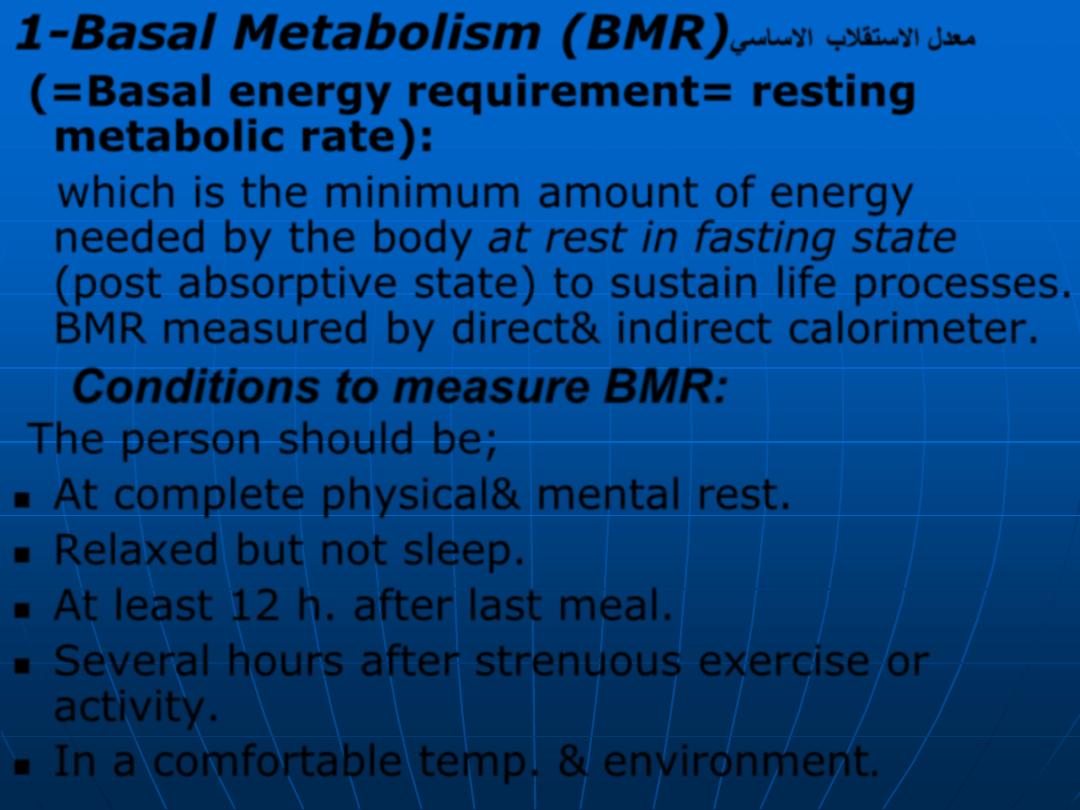
1-Basal Metabolism (BMR)
االساسي
معدل االستقالب
(=Basal energy requirement= resting
metabolic rate):
which is the minimum amount of energy
needed by the body at rest in fasting state
(post absorptive state) to sustain life processes.
BMR measured by direct& indirect calorimeter.
The person should be;
At complete physical& mental rest.
Relaxed but not sleep.
At least 12 h. after last meal.
Several hours after strenuous exercise or
activity.
In a comfortable temp. & environment
.
Conditions to measure BMR:
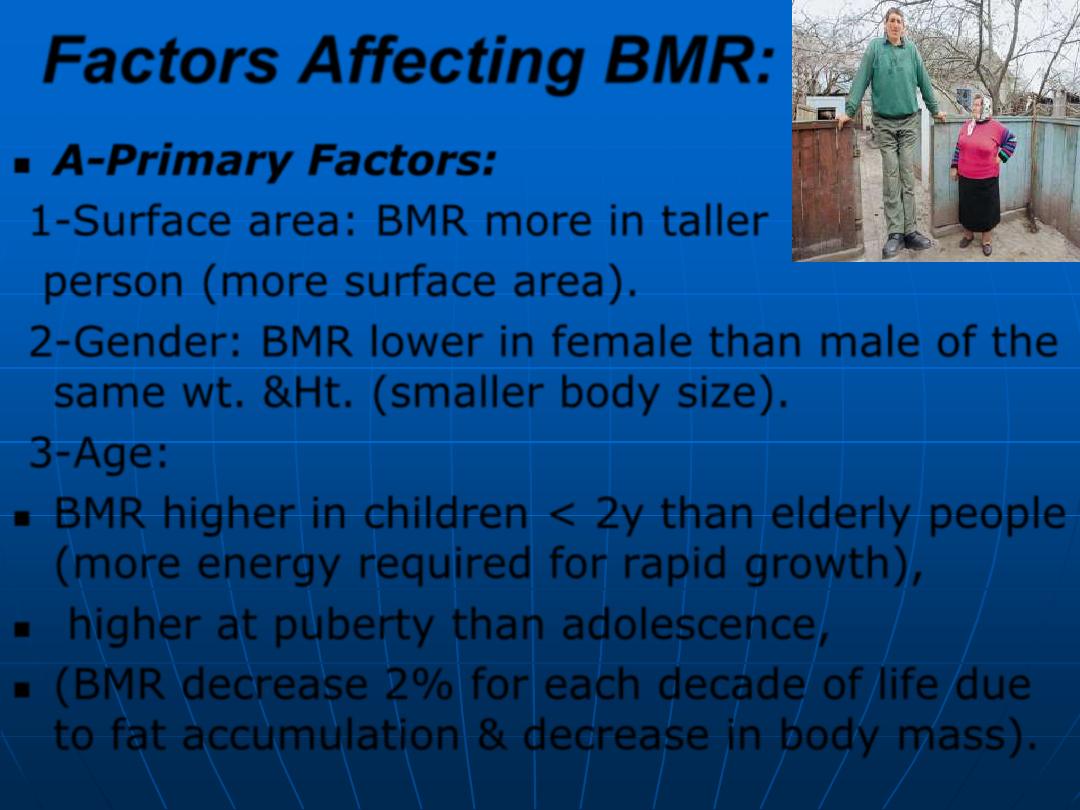
Factors Affecting BMR:
A-Primary Factors:
1-Surface area:
BMR more in taller
person (more surface area).
2-Gender:
BMR lower in female than male of the
same wt. &Ht. (smaller body size).
3-Age:
BMR higher in children < 2y than elderly people
(more energy required for rapid growth),
higher at puberty than adolescence,
(BMR decrease 2% for each decade of life due
to fat accumulation & decrease in body mass).
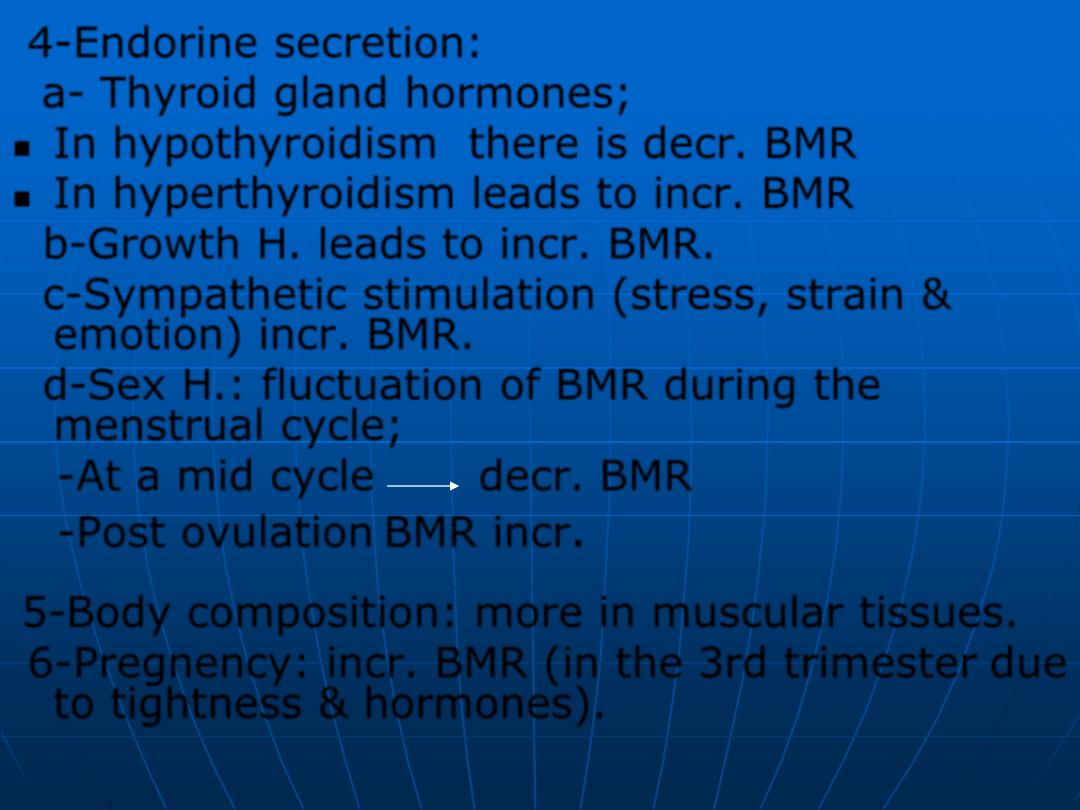
4-Endorine secretion:
a-
Thyroid gland hormones;
In
hypothyroidism
there is decr. BMR
In
hyperthyroidism
leads to incr. BMR
b-Growth H
. leads to incr. BMR.
c-Sympathetic stimulation
(stress, strain &
emotion) incr. BMR.
d-Sex H
.: fluctuation of BMR during the
menstrual cycle;
-At a mid cycle decr. BMR
-Post ovulation
BMR incr
.
5-Body composition:
more in muscular tissues.
6-Pregnency:
incr. BMR (in the 3rd trimester
due
to tightness & hormones).
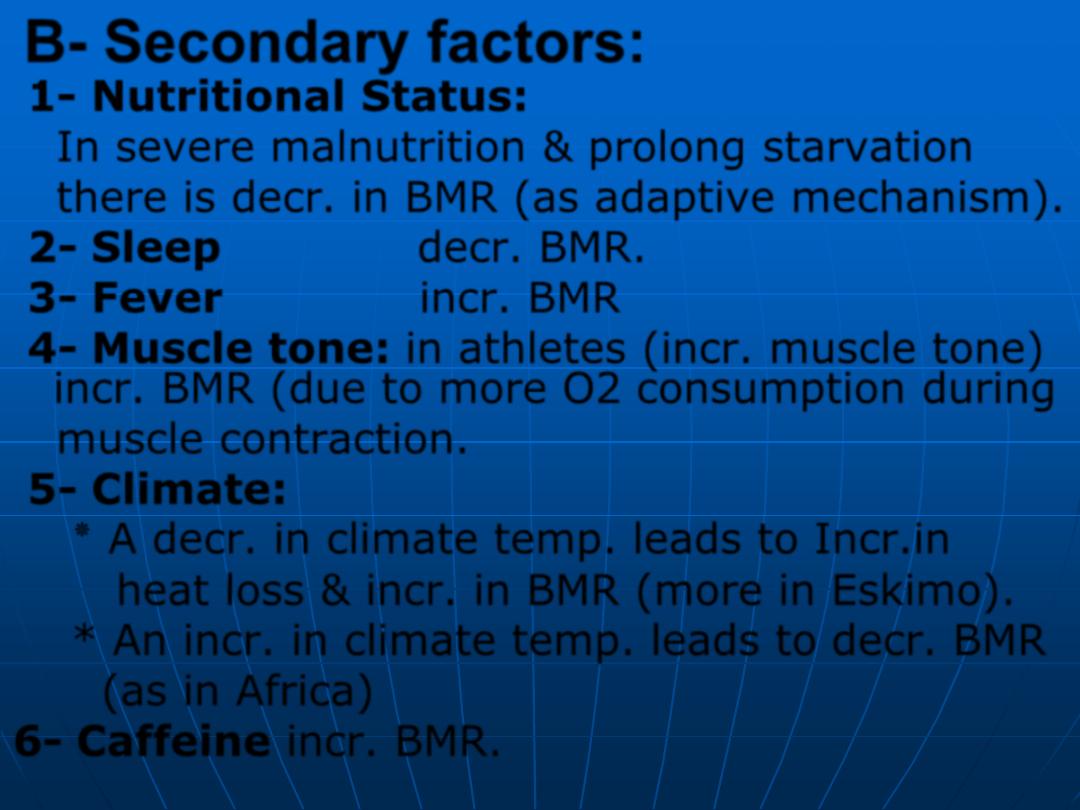
B- Secondary factors:
1- Nutritional Status:
In severe malnutrition & prolong starvation
there is decr. in BMR (as adaptive mechanism).
2- Sleep
leads to decr. BMR.
3- Fever
leads to incr. BMR
4- Muscle tone:
in athletes (incr. muscle tone)
incr. BMR (due to more O2 consumption during
muscle contraction.
5- Climate:
٭A decr. in climate temp. leads to Incr.in
heat loss & incr. in BMR (more in Eskimo).
* An incr. in climate temp. leads to decr. BMR
(as in Africa)
6- Caffeine
incr. BMR.
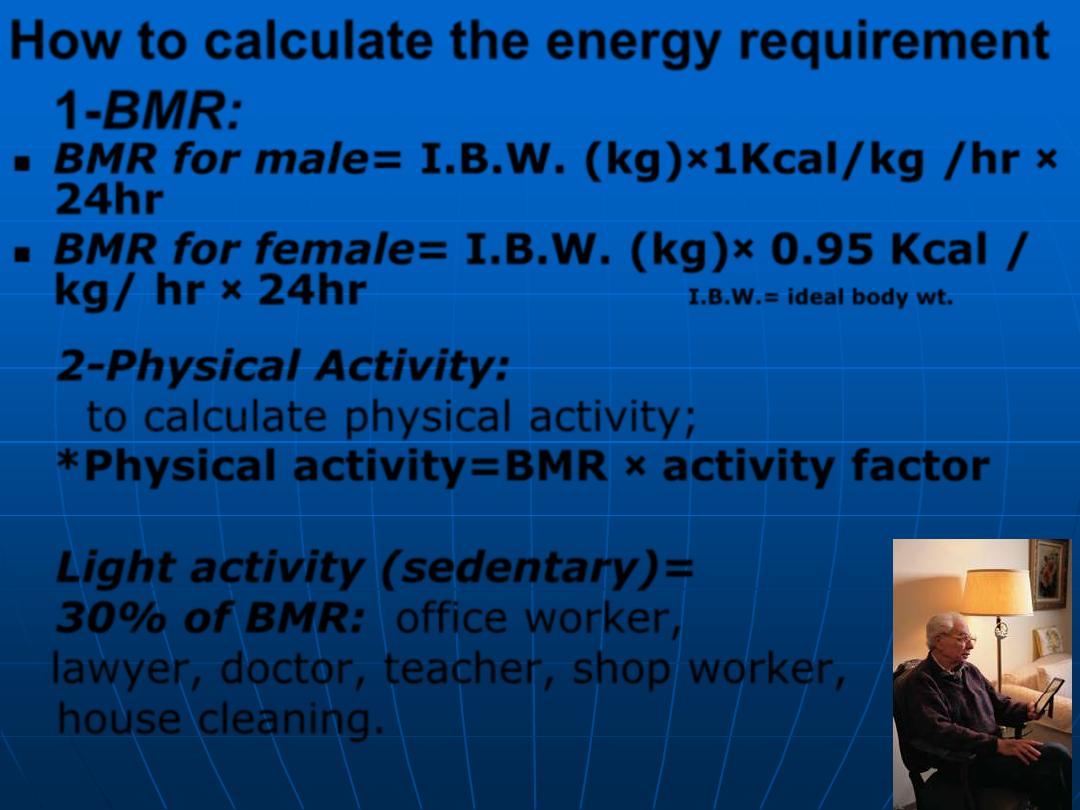
How to calculate the energy requirement
1-BMR:
BMR for
male
= I.B.W. (kg)×1Kcal/kg /hr ×
24hr
BMR for
female
= I.B.W. (kg)×
0.95
Kcal /
kg/ hr ×
24hr
I.B.W.= ideal body wt.
2-Physical Activity:
to calculate physical activity;
*Physical activity=BMR × activity factor
Light
activity (sedentary)=
30%
of BMR: office worker,
lawyer, doctor, teacher, shop worker,
house cleaning.
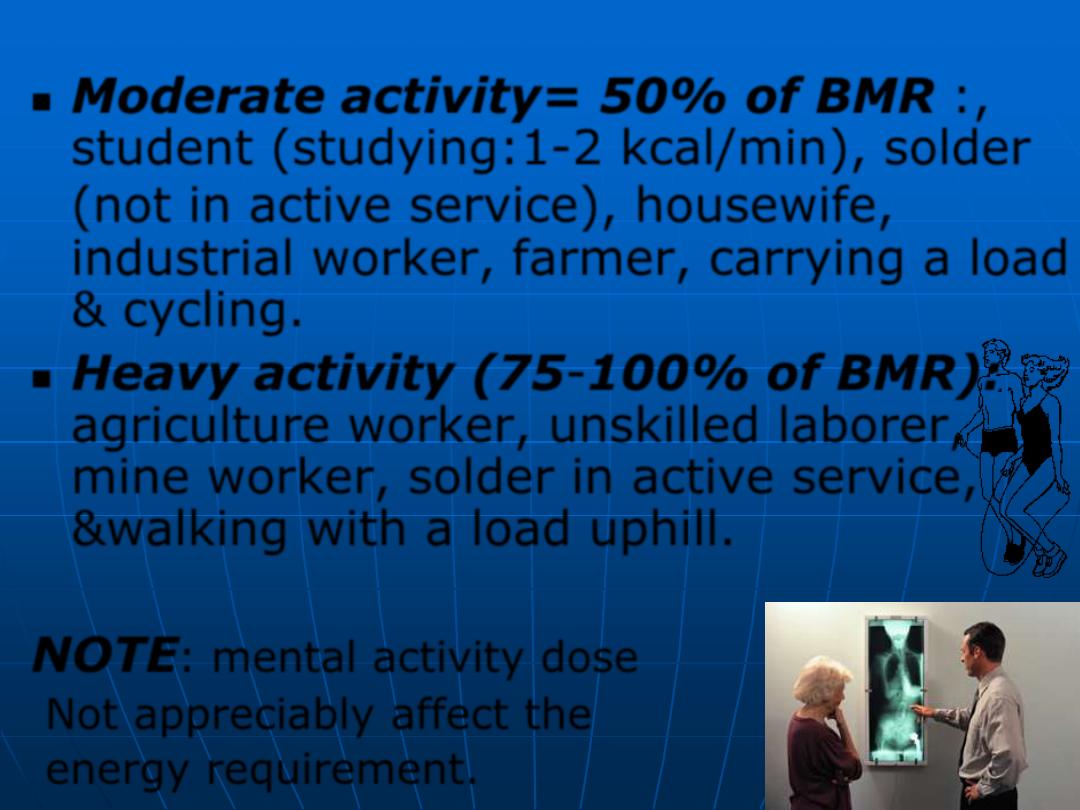
Moderate
activity=
50%
of BMR :,
student (studying:1-2 kcal/min), solder
(not in active service), housewife,
industrial worker, farmer, carrying a load
& cycling.
Heavy
activity (
75-100%
of BMR):
agriculture worker, unskilled laborer,
mine worker, solder in active service,
&walking with a load uphill.
NOTE
:
mental activity dose
Not appreciably affect the
energy requirement.
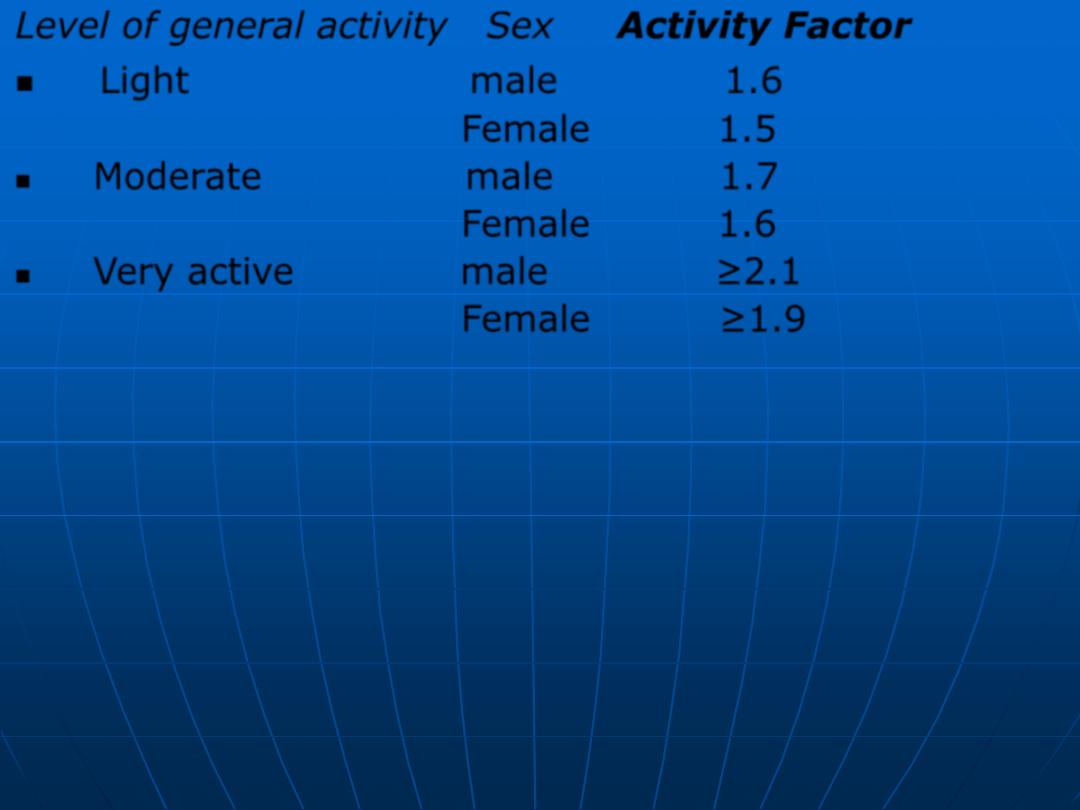
Level of general activity Sex Activity Factor
Light
male 1.6
Female 1.5
Moderate
male 1.7
Female 1.6
Very active
male ≥2.1
Female ≥1.9
3-Thermic Effect of Food (TEF):
which is the extra energy released due to digestion,
absorption, &metabolism of food reaches its
maximum level 3-5 hours after ingestion of food.
This effect is not equal for all type of food;
TEF of protein= 25-30% of BMR
TEF of CHO = 6% of BMR
TEF of fat = 4% of BMR
TEF for
mixed diet= 10% of BMR
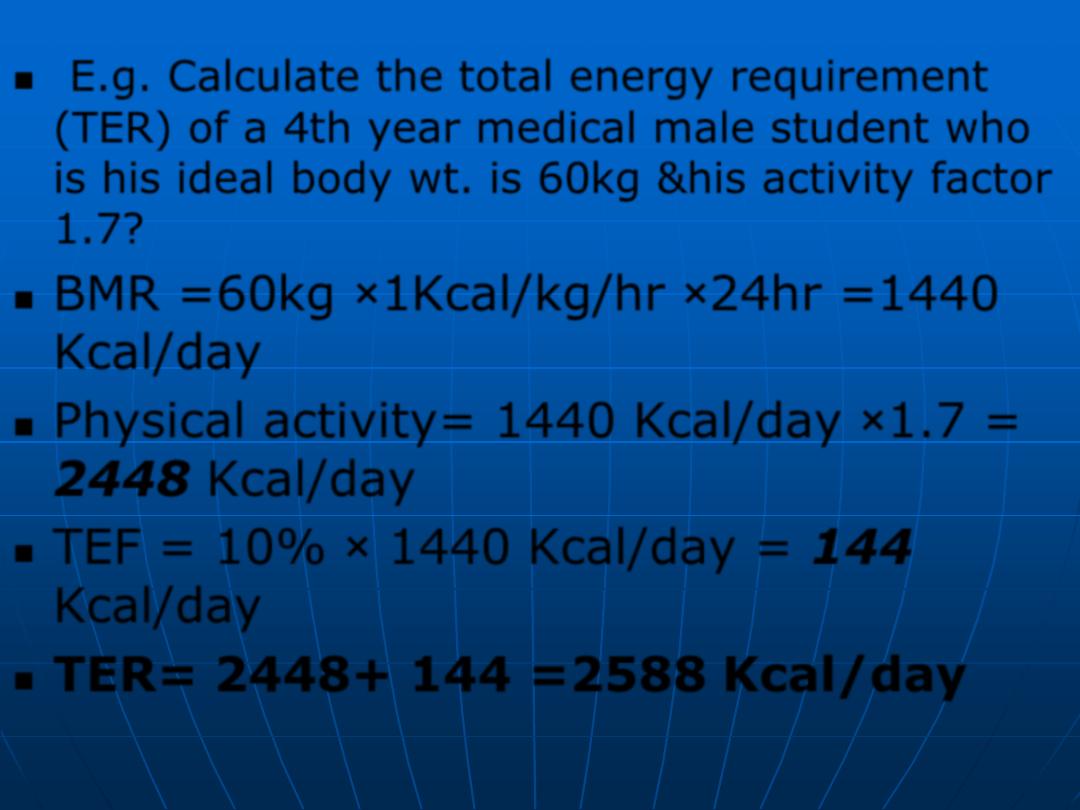
E.g. Calculate the total energy requirement
(TER) of a 4th year medical male student who
is his ideal body wt. is 60kg &his activity factor
1.7?
BMR =60kg ×1Kcal/kg/hr ×24hr =1440
Kcal/day
Physical activity= 1440 Kcal/day ×1.7 =
2448 Kcal/day
TEF = 10% × 1440 Kcal/day = 144
Kcal/day
TER= 2448+ 144 =2588 Kcal/day
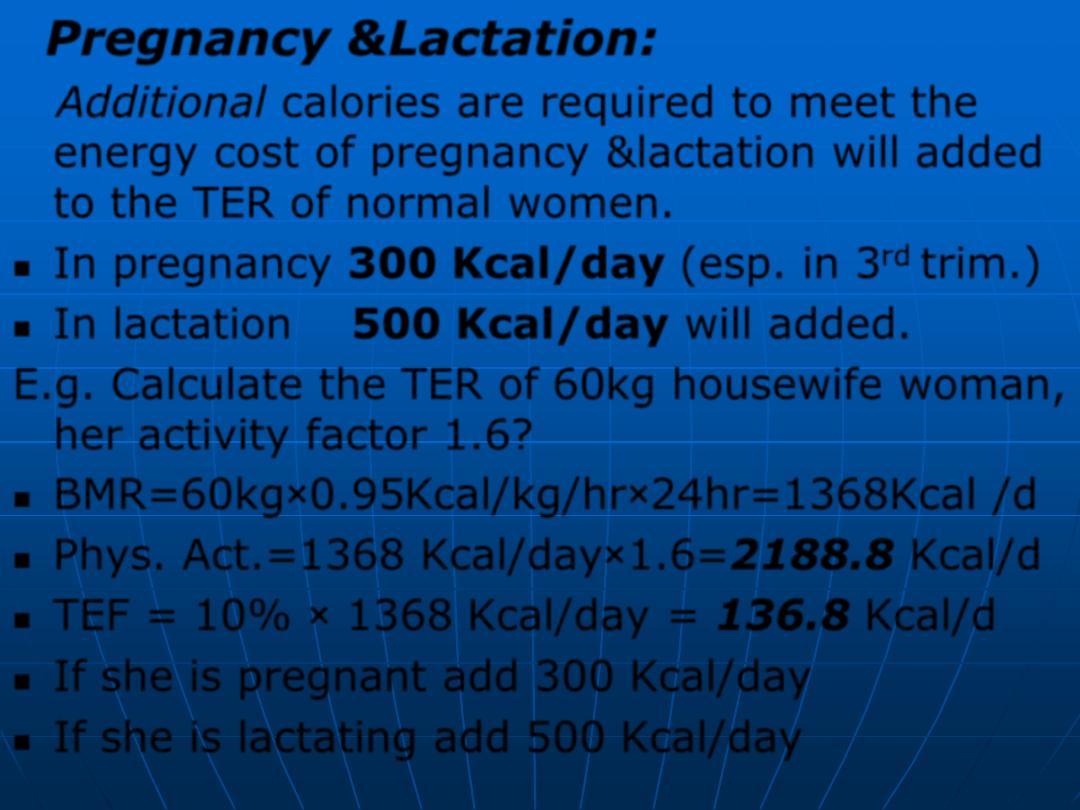
Pregnancy &Lactation:
Additional calories are required to meet the
energy cost of pregnancy &lactation will added
to the TER of normal women.
In pregnancy
300 Kcal/day
(esp. in 3
rd
trim.)
In lactation
500 Kcal/day
will added.
E.g. Calculate the TER of 60kg housewife woman,
her activity factor 1.6?
BMR=60kg×0.95Kcal/kg/hr×24hr=1368Kcal /d
Phys. Act.=1368 Kcal/day×1.6=2188.8 Kcal/d
TEF = 10% × 1368 Kcal/day = 136.8 Kcal/d
If she is pregnant add 300 Kcal/day
If she is lactating add 500 Kcal/day

Recommended Intake (R.I.)=Recommended
daily allowances (R.D.A.):
They are levels of intake of essential
nutrients considered to be adequate to
meet the known nutritional needs of
practically all healthy persons based on
age, sex, type of activity, physiological
needs (pregnancy, lactation, growth
status, ----), pathological status (fever,
accidents, stress-----).
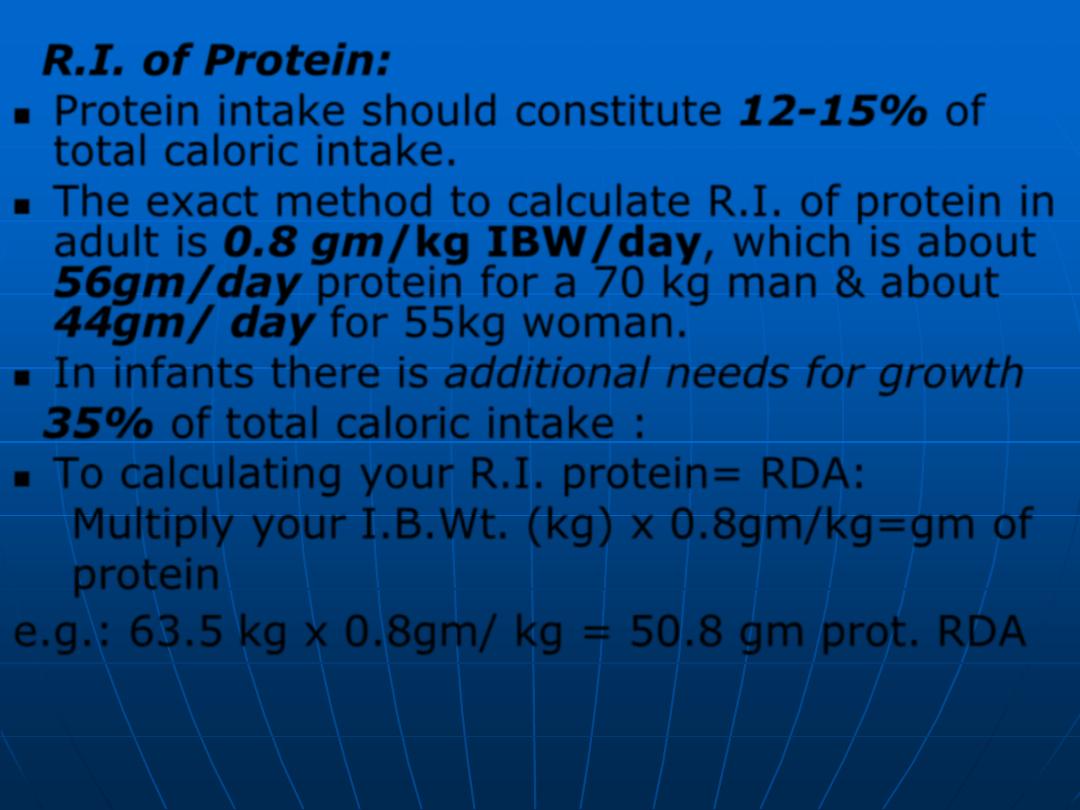
R.I. of Protein:
Protein intake should constitute
12-15%
of
total caloric intake.
The exact method to calculate R.I. of protein in
adult is 0.8 gm/kg IBW/day
, which is about
56gm/day
protein for a 70 kg
man
& about
44gm/ day
for 55kg
woman
.
In infants there is
additional needs for growth
35%
of total caloric intake :
To calculating your R.I. protein=
RDA
:
Multiply your I.B.Wt. (kg) x 0.8gm/kg=gm of
protein
e.g.: 63.5 kg x 0.8gm/ kg = 50.8 gm prot. RDA

R.I. of CHO:
50-60%
of total caloric intake should be CHO.
In a diet contain only CHO it produce sodium
retention& associated water retention.
There is no specific R.I. in CHO, but should be
not less than 50-100gm of digestible CHO /day.
If daily intake less than 50gm/day leads
to
ketosis & electrolyte loss
.
To calculating your R.I. of CHO:
60% X total caloric intake =Kcal of CHO ÷
4Kcale = gms of CHO/ day
e.g. 60% x 2500 Kcal =1500 Kcal CHO ÷ 4
=375gm CHO/ day
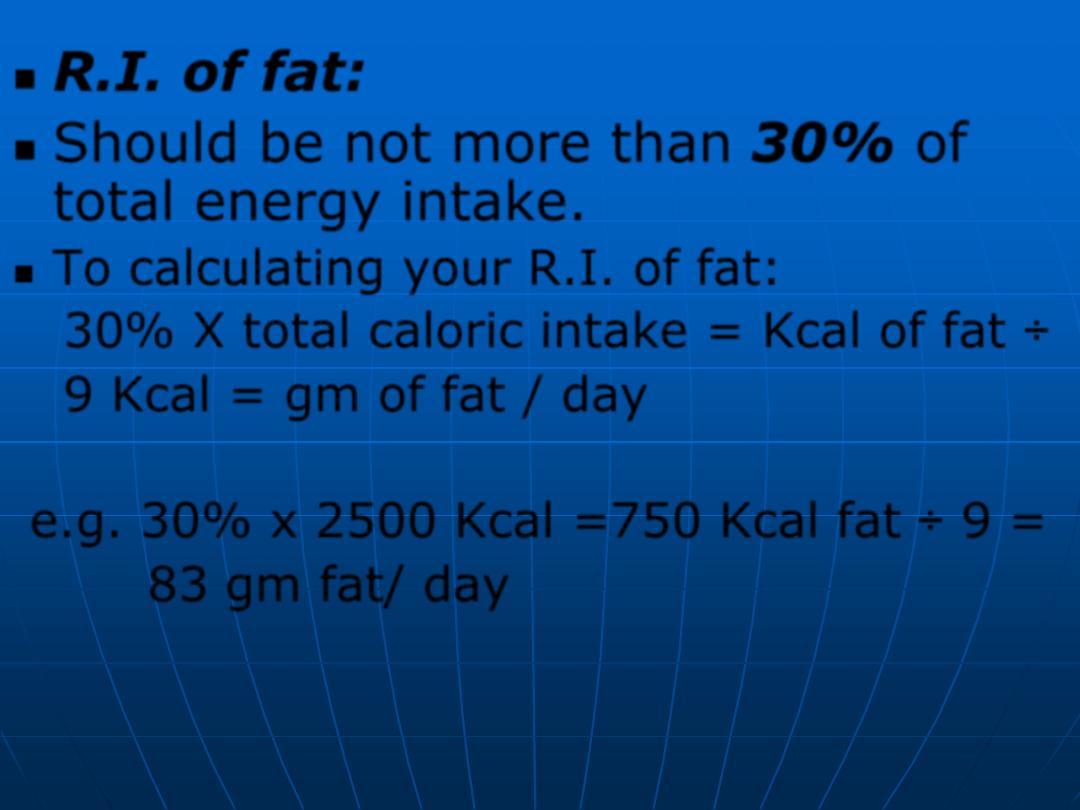
R.I. of fat:
Should be not more than
30%
of
total energy intake.
To calculating your R.I. of fat:
30% X total caloric intake = Kcal of fat ÷
9 Kcal = gm of fat / day
e.g. 30% x 2500 Kcal =750 Kcal fat ÷ 9 =
83 gm fat/ day
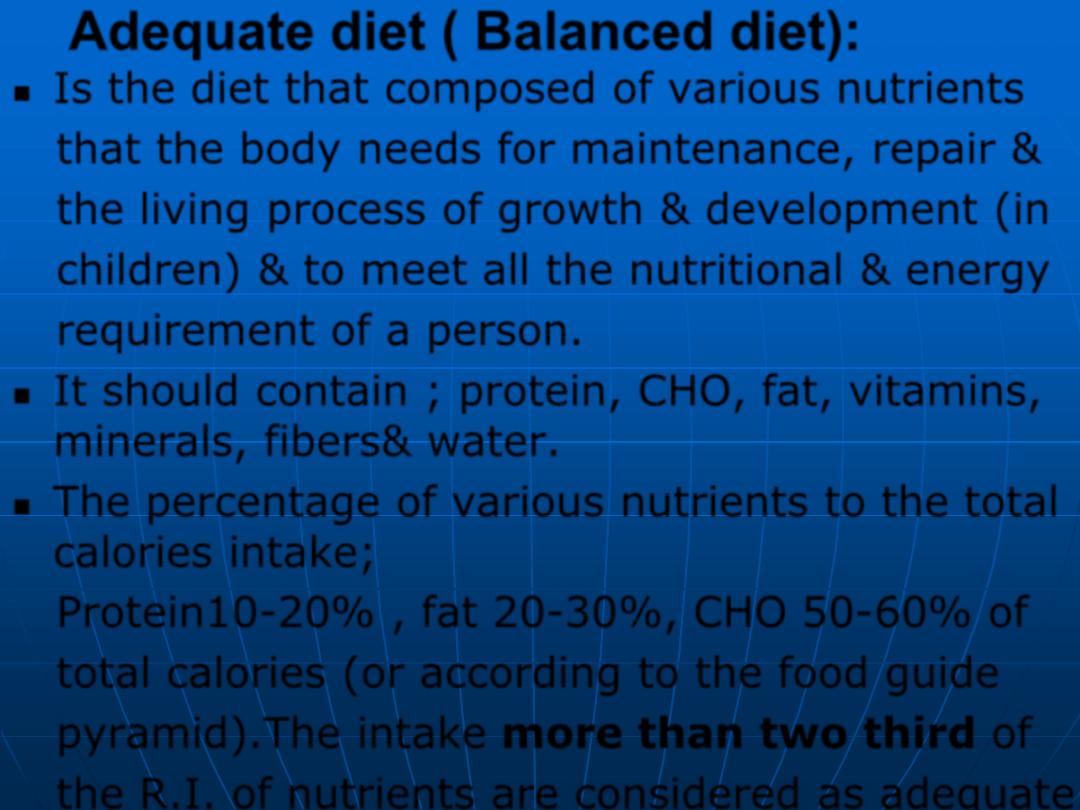
Adequate diet ( Balanced diet):
Is the diet that composed of various nutrients
that the body needs for maintenance, repair &
the living process of growth & development (in
children) & to meet all the nutritional & energy
requirement of a person.
It should contain ; protein, CHO, fat, vitamins,
minerals, fibers& water.
The percentage of various nutrients to the total
calories intake;
Protein10-20% , fat 20-30%, CHO 50-60% of
total calories (or according to the food guide
pyramid).The intake more than two third of
the R.I. of nutrients are considered as adequate.
